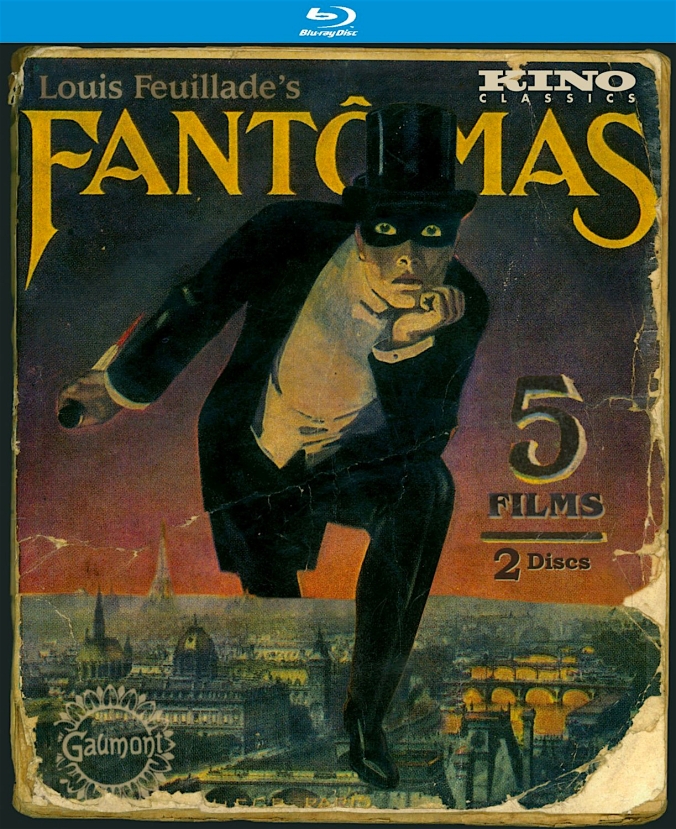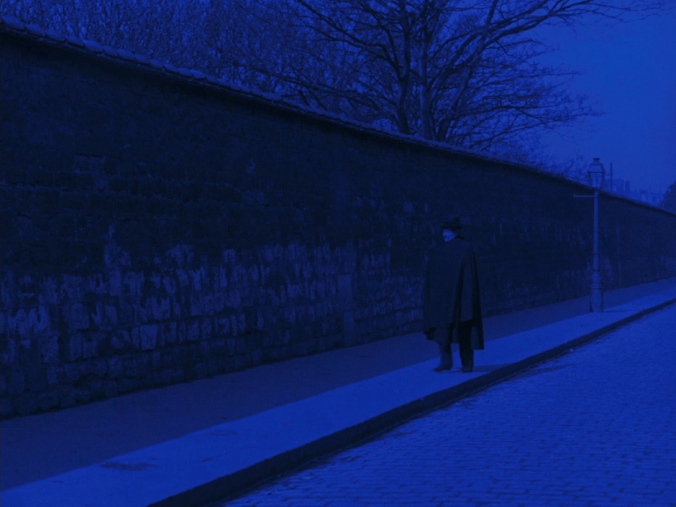
I don’t care that Fantômas is over 100 years old, that it’s silent, or that it’s in French (with English subtitles). You can tell me all day long about how it inspired Fritz Lang’s Dr. Mabuse films (which I love), how the title character has come to be recognized as cinema’s first supervillain, and how influential director Louis Feuillade was to other directors. I knew everything I needed to know in the first scene from the first film: a montage of the villian Fantômas (René Navarre) going through a series of disguises, changing them effortlessly as if he’s shedding skin every few seconds. I knew from that opening that Fantômas was going to be a fun, wild ride, and that’s exactly what it is.
Fantômas is actually a series of five films, released here by Kino, the shortest of which is 57 minutes (the opening film, Fantômas in the Shadow of the Guillotine) and the longest, 97 minutes (the third entry, The Murderous Corpse). The films were released over a two-year period from 1913 to 1914 and were restored in 2006. That edition, also released by Kino, has now been given a 4K restoration through the efforts of Gaumont and le Centre National du Cinéma, in collaboration with the Cinémathèque française.

The basic plot is simple, but it’s execution gets interesting quickly with lots of twists and turns. Fantômas is a criminal mastermind, a master of disguise and a genius of treachery, a man who – with the aid of several lowlife characters – holds Parisians in utter terror. In the first film, Fantômas in the Shadow of the Guillotine, the villain simply steals a set of pearls from an unsuspecting princess. Inspector Juve (Edmund Breon, below left) from the National Police investigates, often aided by his journalist friend Jérôme Fandor (Georges Melchior, second picture below). From that simple starting point, we’re treated to action, adventure, danger, misdirection, cliffhangers, and much more. It would be pointless (and perhaps criminal) to let you in on what happens in subsequent episodes.

The first thing that struck me about this marvelous set is how extraordinary the films look. The restoration is absolutely gorgeous. Watching these movies transcends the feeling of simply going back in time. It’s almost like we’re going to another planet. The images are so clear, so immediate, it’s scary. (The only problems I noticed – a few scratches and blemishes – were with the fifth and final film, and those instances were extremely brief.)
I must also mention the musical score, which is absolutely incredible, far greater and extensive than I had expected. I was not prepared for a score quite this symphonic, but the richness and variety of the music elevates the films to an even higher level. Make no mistake, this is top-notch stuff.

Anyone unfamiliar with silent film should know that there are some things you simply must get used to. One of those things is almost no camera movement. For the most part, the camera is stationary, but in the few instances when it’s not (a couple of panning shots, and one in particular), Feuillade practically brings the house down with the change-ups.

Another big surprise for me was the depth of the sets. I haven’t seen all that many silent films, but in many of those I have seen, the sets have very little depth, appearing more like what you might see in a stage play. Characters enter and exit from either the left, the right, or both, but rarely from the back. Feuillade changes that here, giving many of the sets enormous depth, so much so that when we see a character enter from the back of a room or from a staircase, it’s almost shocking.
If I had to pick a weakness in the set, it would probably be the last film, which was just a bit disappointing in plot and pacing compared to the other four, but not by much.
It’s okay to admit you’ve never seen a silent movie before. Really. No one’s going to judge you (at least not me). But if you haven’t seen a silent film before, these Fantômas films are a great place to start. If the retail price of this Kino Classics set seems a little high, remember that you’re getting five movies here as well as two short films, “The Nativity” (1910) and “The Dwarf” (1912), as well as two audio commentaries by film historian David Kalat and a look at the career of Louis Feuillade. Highly recommended!
UPDATE: I also found this very interesting article called “How to Watch Fantômas and Why.”
The films on 2 Blu-ray discs:
Fantômas in the Shadow of the Guillotine (1913, 58 min.)
Juve vs. Fantômas (1913, 64 min.)
The Murderous Corpse (1913, 97 min.)
Fantômas vs. Fantômas (1914, 61 min.)
The False Magistrate (1914, 75 min.)
4.5/5
(Photos: DVD Beaver, Cinephiled)
Pingback: fantômas | inge note | copyeditor + proofreader
Pingback: Silent Films and Documentaries in 2016 | Journeys in Darkness and Light
Pingback: Movies Watched in January 2016 Part I | Journeys in Darkness and Light
Thanks! This was a really fun set, as was Judex. I hope to see Les Vampires soon. 2016 may just be my year of silent film discoveries!
LikeLike
Great post! This, Les Vampires and Judex I’m very curious to see. There were more Fantomas movies and a French TV series too, would be fun to see how they compare.
LikeLike